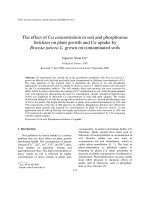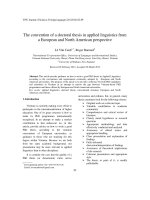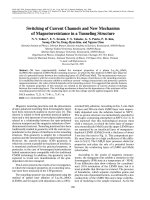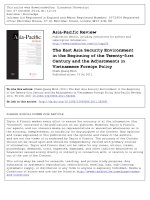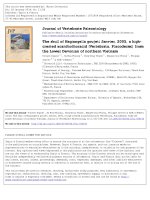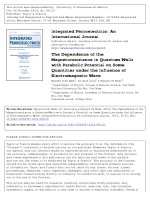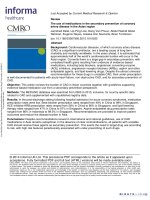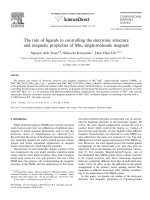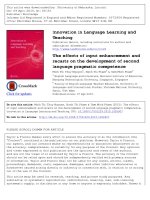DSpace at VNU: The effect of Cu concentration in soil and phosphorus fertilizer on plant growth and Cu uptake by Brassica juncea L'Grown in contaminated soils
Bạn đang xem bản rút gọn của tài liệu. Xem và tải ngay bản đầy đủ của tài liệu tại đây (751.12 KB, 5 trang )
VNU Jo u rn al o i Science, E arth Sciences 24 (2008) 113-117
The effect o f Cu concentration in soil and phosphorous
fertilizer on plant growth and Cu uptake by
B ra ssia ju n c e a L. grown on contaminated soils
Nguyen Xuan Cu*
College o f Science, VNU
Received 17 July 2008; received in revised form 5 September 2008.
A bstract. An experiment was carried out in the greenhouse conditions with Brassica ju n c e a L.
grown on alluvial soils that had previously been contaminated at difTerent concentrations of Cu.
The main purposes of the research were to determine the cíĩects of Cu and phosphorus
applications on plant growth and Cu uptake by Brassica juncea L. Mature plants were harvested
for the Cu accumulation analysis. The soil samples from each growing pot were exữacted by
HNO3 0.43N in order to determine the content of Cu2+mobilization in soil, while the plant samples
vvere acid digested for determining the total Cu concenữation. Atomic Absorption Spectroscopy
(AAS) was employed to determine Cu concentrations in soils and plant samples. The results
showed that adding Cu to soils has strong eíĩects on Brassica juncea L. growth and the uptake rate
of Cu by the plants. The height and the biomass of plants were reduced dramatically by 36% and
53% respectively at the rate of 200 ppm Cu. In addition, phosphorous fertilizer also eíĩectively
improved plant growth and reduccd Cu concentrations in plant of Brassica juncea. At the
application rate of 100 kg P2Oj/ha, the hcight and biomass of plant were increased to 30% and
31% respectively, and the Cu content in plants of Brassica juncea was reduced by 14% comparing
with the conữol samples.
Keywords: Cu in soil; Phosphorous fertilizer; Cu uptake.
1. Introductỉon
Soil pollution by heavy metals is a serious
problem that can have affect on plant growth
and human health. The contaminants o f majors
concem (Cu2\ Zn2+, As2+, Cd2+ and Pb2*) arise
from number o f industrial, mining and
agricultural activities. The high concenừation o f
heavy metals in soil is reílected by higher
concentration o f heavy metals in plants and,
T el.: 84-913023097.
Email: cu n x @ v n u .ed u .v n
consequently, in animal and human bodies [ 2].
Thereíore, plants usually have been used as
indicators o f metal pollution or accumulation in
soil. Besides, plants are also used as
accumulators for soil remediation, which is
called phyto-remediation [5, 7]. The base of
phyto-remediation is pollutant uptake or
bounding by plants [7]. Other possibility to
decrease available concenừation o f pollutants is
stabilization. Phytostabilization can gain results
from eiửier physical or chemical eíĩects of
plants, and o f chemicals, such as phosphate,
lime or clay minerals [3].
114
N .x . Cu / VN U Ịoum al o f Science, Earth Sciences 24 (2008) 113-117
The examination o f the heavy metal, i.e. Cd
and Zn on plant growth and uptake
investigated by Zhang et al., also assist to
elaborate a possible combination o f phosphate
application on heavy metal uptake [1, 4]. The
main purpose o f this research is to investigate
the relation between contents o f Cu in soil and
Cu accumulation in plant, and also the role of
phosphate in reducing the uptake o f Cu by
Brassica juncea L.
2.2. Sampling and chemical analysis
Plant and soil samples were taken and
analysed at the harvest time (45 days after
sowing). Plant samples (leaves and shoots) are
collected and washed with pure water and then
dried at 70°c until stabilisation o f weight. The
monitoring indicators for plants growth include
plant height and biomass. Total Cu in soil and
plant tissues, Cu2+ (HNO3 0.43N) in soil was
determined
by
Atomic
Absorption
Spectroscopy (AAS).
2. Materials and methods
3. Results and discussỉon
2.1. Pot experiments
Alluvial soils collected for pot studies
originated (0-20 cm depth) from Quynh Do
Village (Thanh Tri District, Hanoi City) where
the soil is affected by waste water írom Hanoi
City during agricultural production. The
chemical properties o f soil for pot studies are:
CEC: 23 Cmôl/kg, pH (KC1): 6.15, OM: 2.44%,
total N: 0.32%, total P 2Os: 0.19%, total K 20 :
1.02%, total Cu: 21.29 ppm, niobilization Cu2+
(H N 03 0 43N): 13.38 ppm.
The greenhouse experiment was carried out
in the 2007 year. The soil used for experiment
was artiíĩcially polluted by C u S 0 4 with
signiíicantly diíĩerent rates o f Cu application
(Table 1). Each pot with 5 kg o f soil was sown
with seeds o f Brassica juncea L. and water to
the moisture level o f about 70-80% o f the field
capacity.
Table 1. The treatments layout
rea
Trt.l
Trt.2
Tit.3
Trt.4
Trt.5
Trt.6
Trt.7
nts
Fertilizers
kg/ha
(75+30)
(75+30)
(75+30)
(75+30)
(75+30)
(75+30)
(75+30)
Cu and phosphate added
Cu(ppm) P2O5 kg/ha
0
50
100
200
100
100
100
0
0
0
0
40
60
80
3.1. Ejfects o f Cu appỉication on plan growth
and Cu accumulation in planí
The results o f the effects o f added Cu on
plant grovvth and heavy metal accumulation in
Brassica juncea L. plants are presented in Table
2. Some heavy metals, e.g. Cu, at a low dose
are essential microelement for plants, but in
higher doses they may cause metabolic
disorders and growth inhibition for most o f
plant species.
Table 2. Eữccts of added Cu on plant growth and Cu
content in plants (fresh weight)
Plant
Treatments height
cm %
Trt.l
19.5 100
15.0 77
Trt.2
14.7 75
Trt.3
Trt.4
12.5 64
Plant
vveight
R/pot %
70.3 100
55.9 80
50.0 71
33.1 47
Cu accumulation
in plant
ppm %
2.8
100
3.2
115
190
5.2
308
8.5
The data in Table 2 show the effects of Cu
concentration in soil on the growth rate of
Brassica juncea L. The height o f plants reaches
the highest value of 19.5 cm at T rt.l, and drops
dramatically to 12.5 cm at Trt.4 (drop by 36%)
following the rate o f added Cu increasing to
200 ppm. The effects o f added Cu on biomass
are the same way o f the eíĩects on the height o f
N .x . Cu / V h iu Ịournal o f Science, Earth Sciences 24 (2008) 113-117
plants. The biomass decrease by 53% at the
application rate o f 200 ppm Cu (Trt.4)
compared to the control sample (T rt.l). It is clear
that there is a reduction o f plant growth (plant
height and biomass o f Brassica ịuncea L.) with
increasing concentration o f Cu in soil. The
accumulation of heavy metal in plant tissues of
Brassica juncea L. is reílected the concentration
in soil. The contents o f Cu in plant ìncrease
upon the rates o f Cu application, especially at
the high rate o f Cu above 100 ppm. It can be
said that the increase o f rate o f Cu uptake and
accumulation in plants is much faster than the
decrease o f rate o f plant growth. For example,
the contents o f Cu in plant increase by 208%
when the rate o f Cu application increases to 200
ppm. Meanwhile, the rate o f biomass decreases
only by 53%. The results showed that the
uptake o f Cu by Brassica ju n cea L. plants
corresponded to the increasing level o f Cu
contamination o f soil, vvhile the biomass was
reduced at the high level o f Cu concentration.
3.2. Relationshỉp between content o f Cu1* in
soil with plant growth and Cu accumulation in
plant
The relationship between Cu concentration
in soil and biomass o f Brassica juncea is
presented in Table 3. The highest plant height
and biomass is recognized at T rt.l vvhere the
mobilization of Cu2+(HN030.43 N) is about 13
ppm. But with a higher level o f Cu2+ in soil, the
growth rate o f Brassica ju n c e a decreases
signiíicantly. This trend may be explained by
the toxicity o f Cu to plant. These results might
be also used to evaluate the level o f Cu
pollution in soil. Based on this experiment, one
can suggest that the phyto-toxic threshold of
Cu2+ mobilization to Brassica juncea might be
listed at around 30 ppm, and serious eíĩects can
be seen with the content higher than 50 ppm.
The relationship between Cu2+ concenừation in
soil and Cu content in plant shows a significant
positive effect (Fig. 1 ).
115
Table 3. The contents of Cu2* in soil, Cu content in
plant and plant height (fresh vveight)
Trt
Trt.l
Trt.2
Trt.3
Trt.4
Cu2* in sõĩĩ
(ppm)
13.4
15.5
27.2
51.1
Plant height
(cm)
19.5
15.0
14.7
12.5
Biotnass
(g/pot)
70.3
55.9
50.0
33.1
Cu content in
plant (ppm)
2.8
3.2
5.2
8.5
Cu2* ỉn soỉl (ppm)
—
Plant heigíìt (cm)
■ —
B
k H
ĩi a s *
( g /p o < )
— ầ' ’ ' Cu conteot In plant (ppm)
Fig. 1. The relationship between Cu2+Ũ1 soil with
plant height (Y|), biomass (Y2) and Cu content in
plant (Ỳ3).
3.3. Effecí o f phosphate fertilizer on plant
growth and Cu accumuỉation in plant
In contrast with the results o f Cu application,
phosphate fertilizers have a positive eíĩect on
growth of Brassica juncea at all application
rates. The plant height and biomass o f Brassica
juncea increase up to 130% and 131%
respectìvely comparing to the conừol sample
(Trt.3) without phosphate fertilizer (Table 4).
Tablc 4. The eíĩects of added phosphorus on plant
growth and Cu accumulation in plants of Brassica
juncea (fresh wcight)
Plant
Treatment height
cm %
Trt.3
14.7 100
Trt.5
16.3 114
Trt.6
17.4 118
Trt.7
19.1 130
Plant
weight
g/pot
50.0
53.1
57.3
65.5
%
100
106
115
131
Cu content in
plant
ppm
%
5.2
100
5.1
98
4.8
92
86
4.5
116
N .x . Cu / VN U loum al o f Science. Earth Sciences 24 (2008) 113-117
The đata in Table 4 show that phosphate
íertiliser not only improves the plant growth,
but also is the íactor iníluencing on heavy metal
uptake by plant. The positive eíĩects of
phosphate
fertilizer
on
reducing
Cu
accumulation in plant were recognized at all
rates o f phosphate application. However, this
effect is signiíìcant only at rates greater than 60
kg p 20 5/ha. At 100 kg P 2Os/ha răte, the content
of Cu in plants o f Brassica juncea is reduced by
14% compared to the control sample.
In general, there is a reduction in growth
rate o f Brassica juncea when the content o f Cu
in soil increases whereas the content o f Cu in
plant decreases (Fig. 2). The data founđ in this
study indicated that Cu2+ concentration in soil
has sừong eíTects on the growth o f Brassica
juncea'even at moderate concentration o f about
30 ppm.
0
P ia n t
0 3 B
io m
O ũ C u in
h e > g W
a s s
( c m
)
( ọ /p o ( )
p i a n t ( p p m
)
Trt-1 Trt-2 Trt-3 Trt.4 Trt 5 Tft 6 Tit7
Fig. 2. E ffects o f C u and phosphate fertilizer on
p lan t grow th and C u accum ulation in p lan t o f
B rassica.
Acknovvledgements
The authors acknowledge financial support
of the Asian Center through funding from
Vietnam National University-Hanoi (VNU) for
conducting this research.
4. Conclusions
The grovvth rate o f Brassica juncea is
signiíicantly affected by the Cu2+ concentration
in soil at 30 ppm, and strongly affected by the
concentration at about 50 ppm which is
equivalent to the application rate o f 200 ppm
Cu. The height and the biomass o f plants are
reduced dramatically by 36% and 53%
respectively when the rate o f added Cu
increases to 200 ppm. However, a further study
is needed in order to establish the maximum
amount o f Cu that the plants to grow in these
soils.
In addition, a signiíicant reduction of Cu
content in Brassica juncea is found when
phosphorous fertilizer application at the rate
higher than 80kg P 2Os/ha. At the application
rate o f 80kg p 205/ha, the height and biomass of
plant are increased by 30% and 31%
respectively, and the content o f Cu in plant is
reduced by 14% compared to the control
sample.
References
[1] V. Angclova, R. Ivanova, K.R. Ivanov, Study on
accum ulation o f hcavy metals by plants in íìeld
condition, G eophysicaỉ Research A bstracts,
Vol.7, 03931, 2005, Europcan G eosciences
Union.
[2] D.A. Cataldo, R.E. VVildung, Soil and plant
factors iníluencing on the accumulation o f heavy
m etals
by plants,
Environm ental health
Perspectives, 27 (197 8) 149-159.
[3] S.B. Chen, M .G. Xu, 2002, Evaluation o f
phosphate application on Pb, Cd, and Zn
bioavability in m etal
contaminated soil,
Environm ental Ecotoxicity & Safety 1 (2006) 74.
[4] A. Laníley, M. G ilbey, B. Kennedy (eds.)>
Health and environmental assessment o f
contam inated sitcs, Proceedings o f the Fifíh
N ational Workshop on the Assessment o f Site
Contamination, National Environment Protection
Council Service Corporation, Adelaide> Australia,
2003.
N .x . Cu Ị VN U Ịournal of Science, Earth Sciences 24 (2008) 113-117
[5]
s.p. M cGrath, F.J. Zhao, and E. Lombi,
Phytorem ediation o f m ctals, m ctalloids and
radionuclides, Advances in Agronomy 75 (2002) 1.
[6]
s.
R. Naidu, D. Oliver,
McConnell, Heavy metal
phytotoxicity in soils, In: A. Laníley, M. Gilbey,
B. K ennedy (eds.), Proceedings o f the fìfth
nationaỉ workshop on the assessm ent o f site
contam ination, A delaide SA 5000, 2003, 235.
[7] L.H. W u, Y.M . Luon, X.R. Xing, and p.
Christie, EDTA enhanccd phytorem ediation o f
heavy m etal contam inated soi] and associated
risk, A griculture, Ecosystem s & Environment
102 (2004)307.
